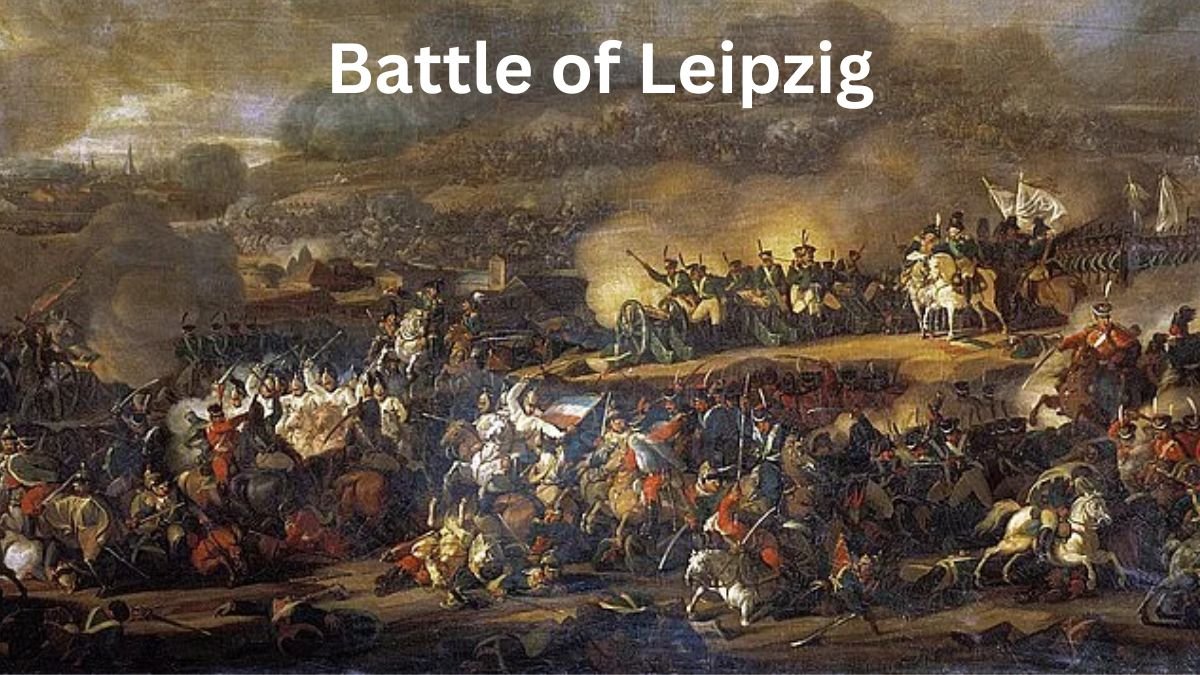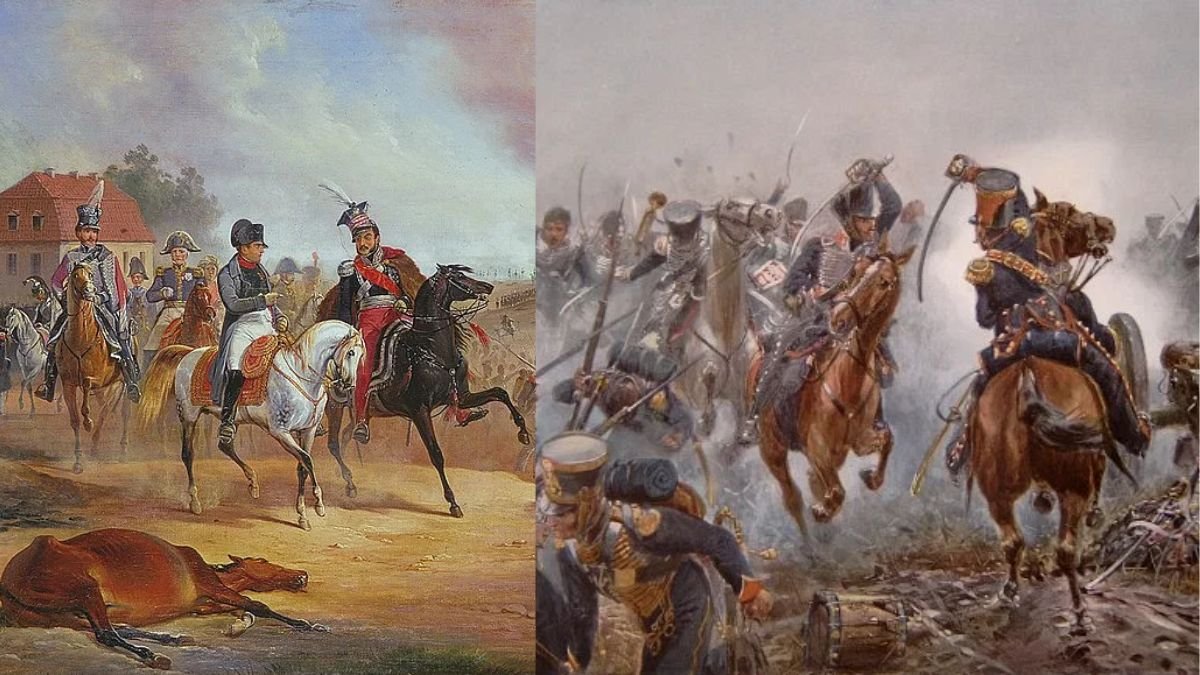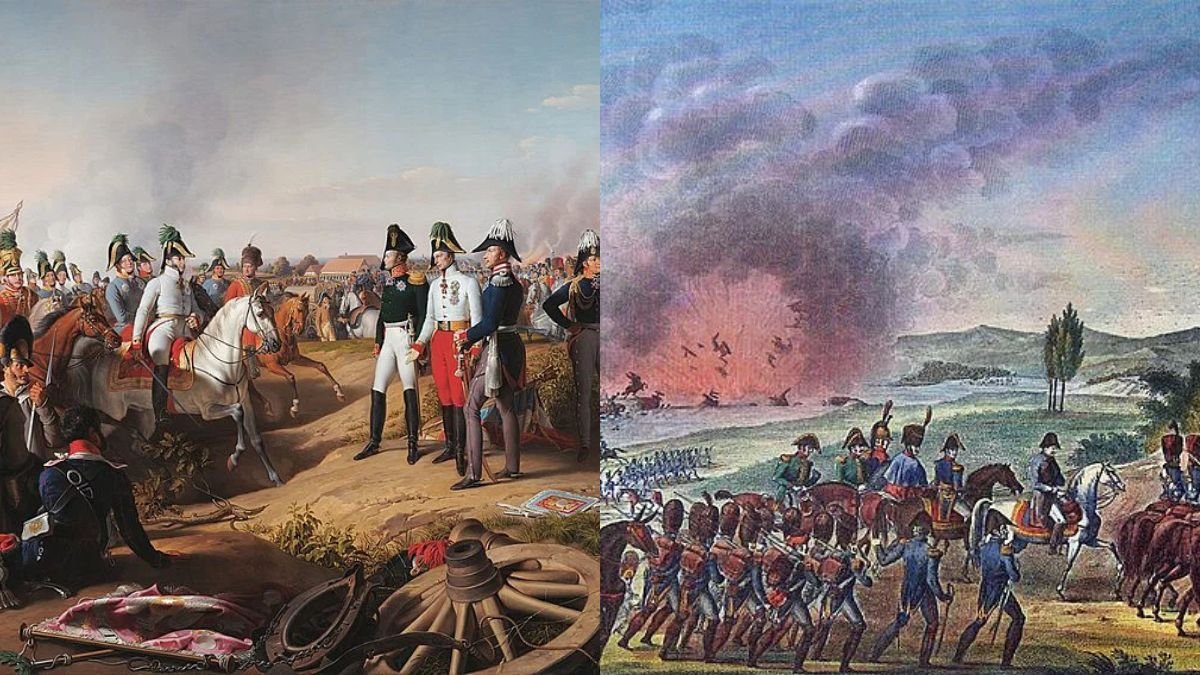Battle of Leipzig: Causes, Effects, and Results

Battle of Leipzig- Introduction
The Battle of Leipzig, also known as the Battle of the Nations, took place from October 16 to 19 1813. This historic battle, a pivotal event in the Napoleonic Wars (1803-1815), involved an astonishing half a million soldiers and resulted in over 100,000 casualties. It marked the climax of the 1813 German campaign and concluded with the decisive defeat of the French Emperor Napoleon I, who had reigned from 1804 to 1814, and briefly again in 1815.
| War Name | Date | Key Person(s) |
|---|---|---|
| Battle of Leipzig | 16-19 October 1813 | Napoleon Bonaparte, Tsar Alexander I, Prince Karl Philipp of Schwarzenberg, Gebhard Leberecht von Blücher, Prince Charles John (Jean Bernadotte), Prince Józef Poniatowski, Joachim Murat, Marshal Étienne Macdonald, General Ignác Gyulay, General Levin August von Bennigsen, Marshal Auguste de Marmont, General Henri Bertrand, and others involved in the battle. |
The German Campaign
Following Napoleon’s return to Paris in December 1812, it became evident that the stability of his empire was rapidly deteriorating. The disastrous failure of his invasion of Russia, just six months prior, resulted in the loss of nearly half a million soldiers to disease, desertion, starvation, and combat. This catastrophe led to the disintegration of the once-mighty Grande Armée, which lay buried beneath the unforgiving Russian snow.
Simultaneously, Russian forces crossed into Poland with the aim of ending Napoleon’s dominance in Central Europe. Meanwhile, approximately 200,000 French troops were embroiled in the Peninsular War (1807-1814) in Iberia, battling the British, Spanish, and Portuguese. The French defeat at the Battle of Salamanca on July 22, 1812, left Bonapartist Spain in a precarious position, making a potential invasion of France by the Anglo-Spanish-Portuguese forces imminent.
With his empire unraveling, Napoleon had to act swiftly. In a surprising turn of events, he announced both the destruction of the Grande Armée to the shocked French public and the formation of a new army, comprising 150,000 men, to safeguard France. Remarkably, by March 1813, he succeeded in raising this formidable force, primarily through forced conscription.
As Prussia joined forces with Russia in the Treaty of Kalisch (February 1813), both nations pledged not to seek separate peace without the other’s consent, marking the beginning of the War of the Sixth Coalition (1813-1814). Their primary objective was to liberate Germany from Napoleon’s grasp and to achieve this, the Russo-Prussian army invaded Saxony, whose king was one of Napoleon’s staunchest German allies. Despite the relative inexperience of his army and a severe shortage of cavalry due to the loss of horses in Russia, Napoleon pressed on for Saxony in April.
Despite the limitations of his army, Napoleon demonstrated that he remained a formidable military tactician. In the initial stages of the 1813 German campaign, he achieved two significant victories against the Russo-Prussian forces at the Battle of Lützen (May 2) and the Battle of Bautzen (May 20-21). However, his lack of cavalry prevented him from capitalizing on these victories, as the Allied armies managed to retreat and regroup. Although demoralized, the Allies approached Napoleon for an armistice, which he accepted on June 4. Many historians consider this a critical blunder, as it allowed the Allies precious time to regroup and reassess their strategy.
The Trachtenberg Plan
The Sixth Coalition, now bolstered by the inclusion of Austria and Sweden, convened at Trachenberg Castle to formulate a new strategy to defeat Napoleon. The resulting Trachtenberg Plan outlined the creation of three multinational armies. The first was the 230,000-strong Army of Bohemia, commanded by Austrian Field Marshal Karl Philipp, Prince of Schwarzenberg, a talented general who had been compelled to serve Napoleon during the Russian campaign.
The second force was the 140,000-strong Army of the North, under the leadership of Swedish Crown Prince Charles John (formerly known as Jean Bernadotte), who had previously served as a French marshal under Napoleon. Finally, the 105,000-strong Army of Silesia was led by Prussian General Gebhard Leberecht von Blücher, an impassioned patriot seeking vengeance for Prussia’s humiliating defeat in 1806. These armies were intentionally multinational in composition to prevent any one Coalition member from dominating the others.
The Trachtenberg Plan: A Strategic Shift
The second part of the Trachtenberg Plan revolved around a cautious strategy to confront Napoleon. Recognizing the formidable reputation of the French Emperor, no Allied commander was eager to face him directly. Instead, they devised a plan to avoid direct confrontation with Napoleon’s main force. Their focus shifted towards disrupting French supply lines and engaging smaller French detachments led by Napoleon’s subordinates. The ultimate goal was to wear down Napoleon’s army through attrition.
Bavaria’s Defection: Shifting Alliances
Hostilities resumed on August 18, and the Allies put the Trachtenberg Plan into action. French Marshal Nicolas Oudinot, dispatched to seize Berlin, was intercepted and defeated by his former comrade Prince Charles John at Großbeeren on August 23. Simultaneously, another French marshal suffered defeat at the hands of Blücher in the Battle of Katzbach on August 26. Initially, it appeared that the Coalition’s strategy was working.
However, on August 26, Napoleon outmaneuvered Schwarzenberg’s Army of Bohemia, compelling it to engage in the massive Battle of Dresden (August 26-27). This battle resulted in a French victory, but Napoleon’s attempts to exploit it were thwarted as a corps he sent in pursuit of Schwarzenberg was surrounded and defeated at Kulm on August 29-30. The survival of Schwarzenberg’s army, coupled with the consistent defeats suffered by Napoleon’s marshals, nullified the gains from the Battle of Dresden.
As Napoleon faced a series of setbacks, the member states of the Confederation of the Rhine, a league of German states under his protection, watched events closely. German nationalism was on the rise, and concerns about being on the losing side of the war led several of these states to reconsider their loyalties. On October 8, 1813, the Kingdom of Bavaria, once Napoleon’s staunchest German ally, switched sides and joined the Sixth Coalition, followed by several other German states. With Bavaria’s defection, Napoleon witnessed his empire beginning to crumble.
Preparations for the Battle of Leipzig
With the three main Coalition armies converging on him, Napoleon decided to abandon his plans to seize Berlin and instead marched towards Leipzig to protect his lines of communication. He ordered all his forces to concentrate around the city, and by October 14, approximately 177,000 French troops had assembled in the vicinity of Leipzig. In contrast, Schwarzenberg’s army was approaching from the south, while Blücher and Charles John were descending from the northwest. A fourth Coalition army, under General Levin August von Bennigsen, was also closing in. The combined strength of the Allies reached around 325,000 men, and this number continued to grow.
The battlefield of Leipzig was divided by the Elster, Pleisse, Luppe, and Parthe rivers, with the city itself situated at the confluence of the Elster and Pleisse. To the south, the terrain was marked by marshlands and woods, while the west and north featured flatter, more open terrain. The eastern area consisted of ridges interspersed with hamlets. Leipzig, though defended by a dilapidated wall, had been fortified by the French.
This offered Napoleon an excellent defensive position, but he had no intention of fighting a purely defensive battle. Instead, he planned to lead a charge with the bulk of his army, comprising 130,000 troops, against Schwarzenberg’s army positioned between the Pleisse and Parthe rivers. The hope was to defeat Schwarzenberg before the other Allied armies could converge. On October 15, the French spent the entire day positioning themselves for this pivotal engagement.
Simultaneously, in Schwarzenberg’s camp, the monarchs of three major Coalition powers convened: Tsar Alexander I of Russia, Emperor Francis I of Austria, and King Frederick William III of Prussia. Following the advice of Tsar Alexander, Schwarzenberg presented a plan. It called for Blücher’s army to attack from the northwest, with a 19,000-strong Austrian corps led by General Ignác Gyulay threatening Napoleon’s western escape route. The main Allied assault would come from the south, with Russian General Mikhail Barclay de Tolly overseeing an attack on a series of villages (Markkleeberg, Wachau, Liebertwolkwitz), forming the southern part of the French line.

First Day: 16 October
The Battle of Leipzig commenced on the early morning of October 16, under gloomy and rainy skies. In the southern sector of the battlefield, General Kleist’s Prussian corps made significant progress along the Pleisse River. They launched a fierce assault on the village of Markkleeberg, defended by Prince Józef Poniatowski’s Polish troops. The conflict in Markkleeberg, marked by brutal street fighting fueled by racial animosity, persisted through the early morning. Eventually, Poniatowski’s Polish forces were compelled to withdraw from the village. However, the Prussians, led by Kleist, were unable to pursue it due to intense French artillery fire, which kept them pinned down until after 10 a.m.
Simultaneously, Allied troops commanded by Eugen of Württemberg seized the town of Wachau but faced staunch opposition from French cannons. By 11 a.m., the initial momentum of the Allied offensive in the southern front had diminished, prompting Napoleon to launch a counterattack. The French unleashed the firepower of 150 cannons against Kleist’s and Prince Eugen’s troops as Napoleon ordered a general frontal advance.
Marshal Étienne Macdonald was directed to threaten the Allied right flank and stormed the Kolmberg heights. Simultaneously, marshals Poniatowski, Victor, Oudinot, and Augereau led dense attack columns forward. This offensive was supported by Joachim Murat, the King of Naples, who commanded 10,000 French, Italian, and Saxon horsemen. Murat executed a thunderous cavalry charge, cutting through Kleist’s Prussian corps and chasing them as far as Crobern.
At 2:30 p.m., General Bordesoulle led 18 French cavalry squadrons against Prince Eugen’s infantry, creating a deep wedge within the Allied line. Bordesoulle’s charge shattered two Allied battalions and resulted in the capture of 26 guns. His advance brought him perilously close to Tsar Alexander’s command post, potentially making this a decisive moment in the battle. However, Bordesoulle’s progress was hindered by marshy terrain, and the lack of support from French infantry slowed his assault. The Russian Guard Cavalry eventually halted Bordesoulle’s advance, and the opportunity was lost. Nonetheless, Napoleon remained optimistic at this juncture, communicating to the King of Saxony that “all is going well.”
However, developments on the western and northern fronts would soon impede French momentum. In the morning, Austrian troops under Gyulay attacked the western suburb of Lindenau, posing a threat to the French retreat route. Consequently, General Henri Bertrand’s corps was dispatched to expel Gyulay’s forces from the suburb. Fighting in Lindenau persisted throughout the day. While Bertrand retained control of the suburb, the fact that he was pinned down defending Lindenau prevented his corps from participating in Napoleon’s main attack.
In the northern sector at Möckern, Marshal Auguste de Marmont’s corps faced the formidable Prussian army under Blücher. Marmont commanded some of the finest troops in the French army and managed to withstand relentless Prussian assaults. Eventually, Marmont saw an opportunity to rout the Prussian corps and ordered a charge. However, his cavalry commander refused to comply, forcing Marmont to launch the attack with his infantry alone. The Prussian cavalry promptly decimated Marmont’s infantry, forcing them out of Möckern, which fell into Prussian hands.
With Bertrand and Marmont bogged down, Napoleon had to spread his forces thinly, leading to a loss of momentum. Most of the fighting began to dwindle by 5 p.m. The first day of battle inflicted horrific casualties on both sides, with the French suffering 25,000 casualties and the Allies 30,000.
On October 17, there was a temporary lull in the fighting as both sides used the day to rest and gather reinforcements. The situation turned increasingly dire for the French as Bennigsen and Prince Charles John arrived, bolstering the Allied strength by 145,000 additional men. In contrast, Napoleon could only muster 14,000 reinforcements. When Napoleon’s request for an armistice was denied, he began planning for a strategic retreat.
Second Day: 18 October
The Allies devised a plan involving six coordinated attacks against Napoleon on October 18. Blücher and Gyulay were to resume their assaults from the north and west, while additional offensives targeted key southern villages. The ultimate blow was intended to be struck against Napoleon’s army within Leipzig itself. Napoleon, recognizing the need for a retreat, had shortened his defensive line.
The day’s battle began in the morning and initially favored the French. Bertrand successfully repelled Gyulay’s second attack on Lindenau, while Poniatowski’s Polish forces effectively defended the village of Connewitz. However, at 9 a.m., a devastating blow struck the French when 5,400 of Napoleon’s Saxon troops defected to the Coalition. These Saxons, who had previously fought under Charles John at the Battle of Wagram in 1809, still held loyalty to their former commander. This act of betrayal dealt a severe blow to French morale.

Third-Day: 19 October
The chaotic and brutal fighting continued throughout the rest of the day. Probsthedia, a village just southeast of Leipzig, witnessed some of the most intense fighting. Tsar Alexander took a personal interest in capturing this village and ordered Barclay to take it at any cost. Waves of Allied attacks relentlessly pounded the French defenses. Finally, the 3rd Russian Infantry Division managed to breach the village, causing significant casualties among the French infantry.
However, Napoleon’s Imperial Guard counterattacked, driving the Russians back. In the north of Leipzig, an artillery duel raged between Marmont’s 137 guns and 180 Allied cannons at Schönefeld. This fierce artillery battle continued well into the night until Marmont was forced to retreat into Leipzig.
Meanwhile, Blücher’s forces reached the outskirts of Leipzig. During the battle for the suburbs, a British detachment unleashed the terrifying Congreve rockets, which had a profound effect on French morale.
By the afternoon of October 18, Napoleon found himself running low on ammunition and realized that the time had come for a strategic retreat.
The French began their withdrawal at 2 a.m. on October 19, leaving behind 30,000 troops led by Oudinot and Poniatowski to cover the retreat. Unable to construct pontoon bridges, the French had only one route of escape—across a single bridge over the Pleisse River. The retreat quickly descended into chaos as wagons, cannons, livestock, women, wounded soldiers, and troops crowded together.
The Allies did not realize Napoleon was retreating until 7 a.m. and did not launch an attack until 10 a.m. When the Allied assault finally came, Oudinot’s and Poniatowski’s troops successfully held them at bay, allowing for a steady if slow withdrawal.
However, disaster struck during the retreat. Napoleon had ordered the bridge to be destroyed after the entire French army had crossed. The responsibility for this task was entrusted to Colonel Montfort, who abandoned his post early to avoid being the last person out of the city. A young corporal was left to carry out the demolition, and in a moment of panic around 1 p.m., he prematurely detonated the bridge, while it was still congested with wagons and people.
The explosion sent pieces of the bridge, wagons, and body parts flying into the air, trapping thousands of French soldiers in Leipzig. Most of them surrendered, although several thousand attempted to swim across the rivers. Oudinot managed to escape this way, but Poniatowski, weakened by serious wounds, tragically drowned.
With this event, the Battle of Leipzig came to a close. The Allies emerged victorious, but the cost was high, with 54,000 killed and wounded. The French, while suffering fewer battle casualties at around 38,000, lost an additional 30,000 men as prisoners after the bridge was destroyed.
Aftermath
The Battle of Leipzig accelerated the decline of Napoleon’s empire. The King of Saxony, one of Napoleon’s few remaining German allies, was captured shortly after the battle, and the remaining principalities of the Confederation of the Rhine defected to the Coalition. By November, the Confederation ceased to exist, and the French Empire no longer held territories east of the Rhine.
Napoleon hurried back to France to prepare for a new campaign, but the fact that he had lost two armies in as many years tarnished his military reputation irreparably. For six months following Leipzig, Napoleon resisted the Coalition’s invasion of France. However, the fall of Paris in March 1814 marked the end of his rule, and he was compelled to abdicate in April. Exiled to Elba, he would briefly return in the Hundred Days.
The Battle of Leipzig, involving over half a million troops from across Europe, producing over 100,000 casualties, and witnessing the discharge of more than 200,000 rounds of artillery ammunition, marked the resurgence of Prussia as a major power and significantly contributed to Napoleon’s ultimate downfall. It was the largest battle in European history before World War I (1914-1918) and played a pivotal role in shaping post-Napoleonic Europe during the Congress of Vienna.
- Loebinger Bitter Confession: Former pole vault star Tim Lobinger is fighting cancer again
- Bastille Day 2023: History, Significance, Celebration, and Impact
- Benito Mussolini: Life of Fascist Dictator-Early Life, Parents, Wife Girlfriend Children, Career, Death